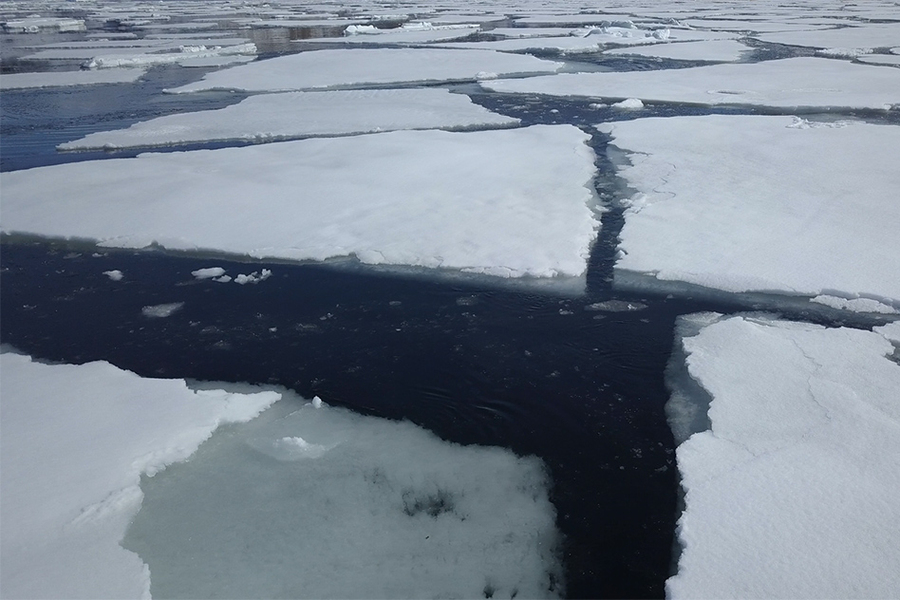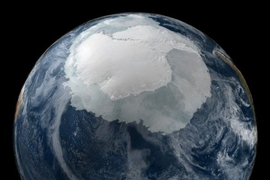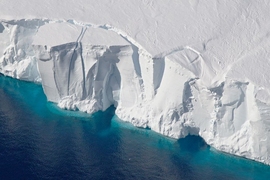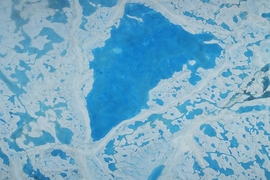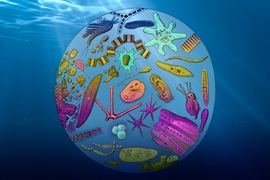The Southern Ocean surrounding Antarctica is a region where many of the world’s carbon-rich deep waters can rise back up to the surface. Scientists have thought that the vast swaths of sea ice around Antarctica can act as a lid for upwelling carbon, preventing the gas from breaking through the ocean’s surface and returning to the atmosphere.
However, researchers at MIT have now identified a counteracting effect that suggests Antarctic sea ice may not be as powerful a control on the global carbon cycle as scientists had suspected.
In a study published in the August issue of the journal Global Biogeochemical Cycles, the team has found that indeed, sea ice in the Southern Ocean can act as a physical barrier for upwelling carbon. But it can also act as a shade, blocking sunlight from reaching the surface ocean. Sunlight is essential for phytosynthesis, the process by which phytoplankton and other ocean microbes take up carbon from the atmosphere to grow.
The researchers found that when sea ice blocks sunlight, biological activity — and the amount of carbon that microbes can sequester from the atmosphere — decreases significantly. And surprisingly, this shading effect is almost equal and opposite to that of sea ice’s capping effect. Taken together, both effects essentially cancel each other out.
“In terms of future climate change, the expected loss of sea ice around Antarctica may therefore not increase the carbon concentration in the atmosphere,” says lead author Mukund Gupta, who carried out the research as a graduate student in MIT’s Department of Earth, Atmospheric and Planetary Sciences (EAPS).
He emphasizes that sea ice does have other effects on the global climate, foremost through its albedo, or ability to reflect solar radiation.
“When the Earth warms up, it loses sea ice and absorbs more of this solar radiation, so in that sense, the loss of sea ice can accelerate climate change,” Gupta says. “What we can say here is, sea ice changes may not have such a strong effect on carbon outgassing around Antarctica through this capping and shading effect.”
Gupta’s coauthors are EAPS Professor Michael “Mick” Follows, and EAPS research scientist Jonathan Lauderdale.
The role of ice
Each winter, wide swaths of the Southern Ocean freeze over, forming vast sheets of sea ice that extend out from Antarctica for millions of square miles. The role of Antarctic sea ice in regulating the climate and the carbon cycle has been much debated, though the prevailing theory has been that sea ice can act as a lid to keep carbon in the ocean from escaping to the atmosphere.
“This theory is mostly thought of in the context of ice ages, when the Earth was much colder and the atmospheric carbon was lower,” Gupta says. “One of the theories explaining this low carbon concentration argues that because it was colder, a thick sea ice cover extended further into the ocean, blocking carbon exchanges with the atmosphere and effectively trapping it in the deep ocean.”
Gupta and his colleagues wondered whether an effect other than capping may also be in play. In general, the researchers have sought to understand how various features and processes in the ocean interact with ocean biology such as phytoplankton. They assumed that there might be less biological activity as a result of sea ice blocking microbes’ vital sunlight — but how strong would this shading effect be?
Equal and opposite
To answer that question, the researchers used the MITgcm, a global circulation model that simulates the many physical, chemical, and biological processes involved in the circulation of the atmosphere and ocean. With MITgcm, they simulated a vertical slice of the ocean spanning 3,000 kilometers wide and about 4,000 meters deep, and with conditions similar to today’s Southern Ocean. They then ran the model multiple times, each time with a different concentration of sea ice.
“At 100 percent concentration, there are no leaks in the ice, and it’s really compacted together, versus very low concentrations representing loose and sparse ice floes moving around,” Gupta explains.
They set each simulation to one of three scenarios: one where only the capping effect is active, and sea ice is only influencing the carbon cycle by preventing carbon from leaking back out to the atmosphere; another where only the shading effect is active, and sea ice is only blocking sunlight from penetrating the ocean; and the last in which both capping and shading effects are in play.
For every simulation, the researchers observed how the conditions they set affected the overall carbon flux, or amount of carbon that escaped from the ocean to the atmosphere.
They found that capping and shading had opposite effects on the carbon cycle, reducing the amount of carbon to the atmosphere in the former case and increasing it in the latter, by equal amounts. In the scenarios where both effects were considered, one canceled the other out almost entirely, across a wide range of sea ice concentrations, leading to no significant change in the carbon flux. Only when sea ice was at its highest concentration did capping have the edge, with a decrease in carbon escaping to the atmosphere.
The results suggest that Antarctic sea ice may effectively trap carbon in the ocean, but only when that ice cover is very expansive and thick. Otherwise, it seems that sea ice’s shading effect on the underlying organisms may counteract its capping effect.
“If one just considered the physics and the pure capping, or carbon barrier idea, that would be an incomplete way of thinking about it,” Gupta says. “This shows that we need to understand more of the biology under sea ice and how it underlies this effect.”
This research was supported in part by the U.S. National Science Foundation.
